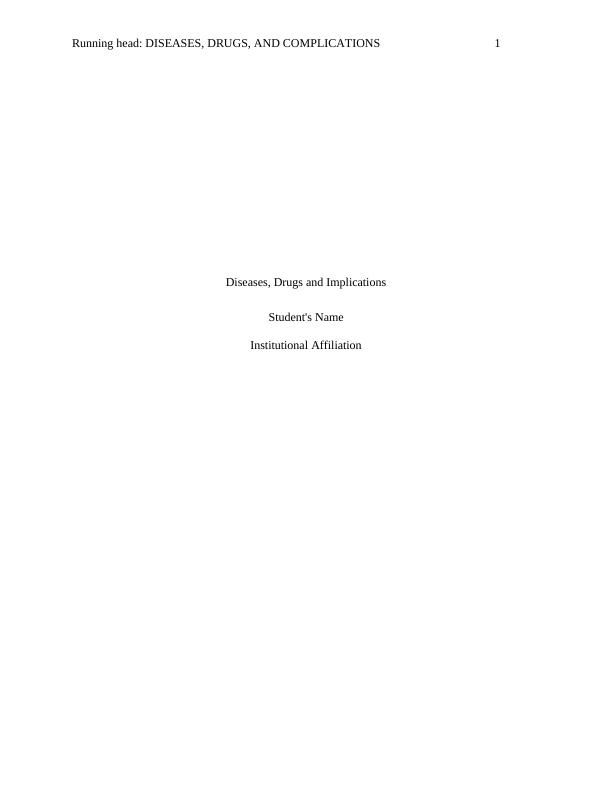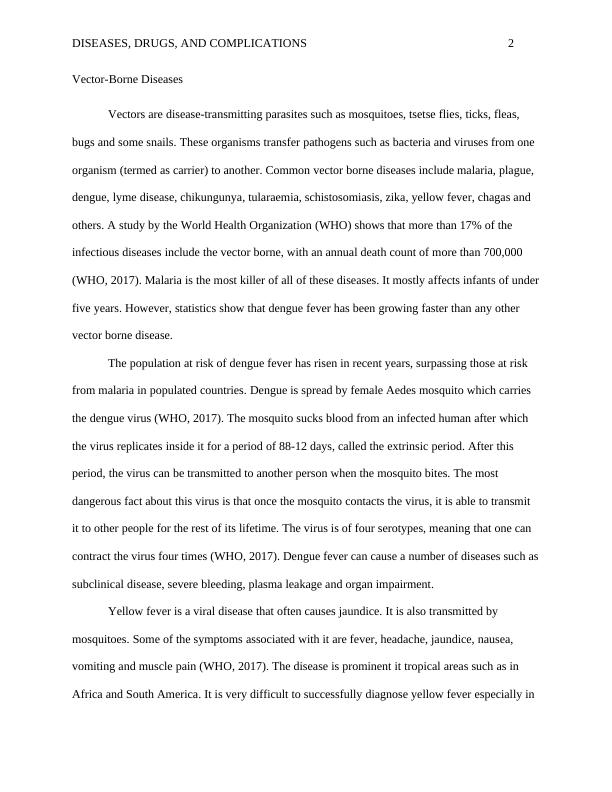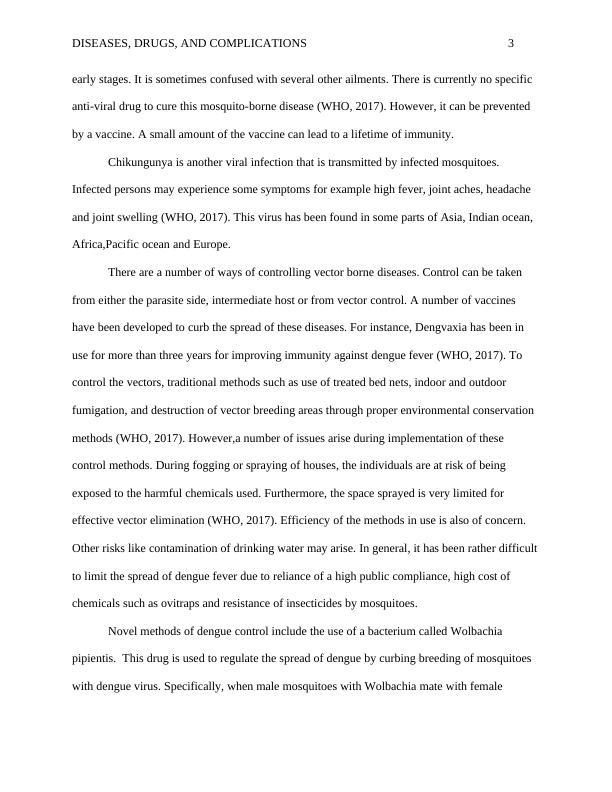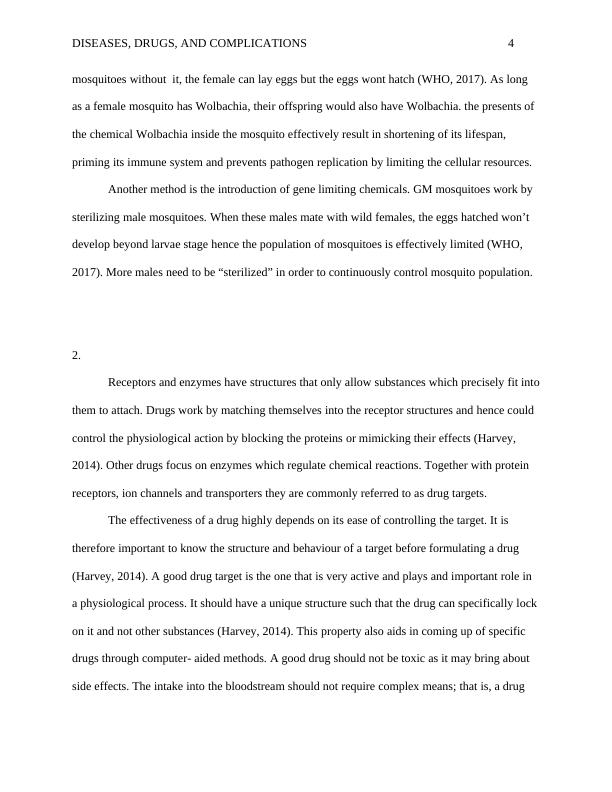Diseases Ddrugs And Complications
Recap of practical, protein electrophoresis, Western blotting, and exam question structure.
13 Pages3883 Words23 Views
Added on 2022-09-09
Diseases Ddrugs And Complications
Recap of practical, protein electrophoresis, Western blotting, and exam question structure.
Added on 2022-09-09
ShareRelated Documents
Running head: DISEASES, DRUGS, AND COMPLICATIONS 1
Diseases, Drugs and Implications
Student's Name
Institutional Affiliation
Diseases, Drugs and Implications
Student's Name
Institutional Affiliation

DISEASES, DRUGS, AND COMPLICATIONS 2
Vector-Borne Diseases
Vectors are disease-transmitting parasites such as mosquitoes, tsetse flies, ticks, fleas,
bugs and some snails. These organisms transfer pathogens such as bacteria and viruses from one
organism (termed as carrier) to another. Common vector borne diseases include malaria, plague,
dengue, lyme disease, chikungunya, tularaemia, schistosomiasis, zika, yellow fever, chagas and
others. A study by the World Health Organization (WHO) shows that more than 17% of the
infectious diseases include the vector borne, with an annual death count of more than 700,000
(WHO, 2017). Malaria is the most killer of all of these diseases. It mostly affects infants of under
five years. However, statistics show that dengue fever has been growing faster than any other
vector borne disease.
The population at risk of dengue fever has risen in recent years, surpassing those at risk
from malaria in populated countries. Dengue is spread by female Aedes mosquito which carries
the dengue virus (WHO, 2017). The mosquito sucks blood from an infected human after which
the virus replicates inside it for a period of 88-12 days, called the extrinsic period. After this
period, the virus can be transmitted to another person when the mosquito bites. The most
dangerous fact about this virus is that once the mosquito contacts the virus, it is able to transmit
it to other people for the rest of its lifetime. The virus is of four serotypes, meaning that one can
contract the virus four times (WHO, 2017). Dengue fever can cause a number of diseases such as
subclinical disease, severe bleeding, plasma leakage and organ impairment.
Yellow fever is a viral disease that often causes jaundice. It is also transmitted by
mosquitoes. Some of the symptoms associated with it are fever, headache, jaundice, nausea,
vomiting and muscle pain (WHO, 2017). The disease is prominent it tropical areas such as in
Africa and South America. It is very difficult to successfully diagnose yellow fever especially in
Vector-Borne Diseases
Vectors are disease-transmitting parasites such as mosquitoes, tsetse flies, ticks, fleas,
bugs and some snails. These organisms transfer pathogens such as bacteria and viruses from one
organism (termed as carrier) to another. Common vector borne diseases include malaria, plague,
dengue, lyme disease, chikungunya, tularaemia, schistosomiasis, zika, yellow fever, chagas and
others. A study by the World Health Organization (WHO) shows that more than 17% of the
infectious diseases include the vector borne, with an annual death count of more than 700,000
(WHO, 2017). Malaria is the most killer of all of these diseases. It mostly affects infants of under
five years. However, statistics show that dengue fever has been growing faster than any other
vector borne disease.
The population at risk of dengue fever has risen in recent years, surpassing those at risk
from malaria in populated countries. Dengue is spread by female Aedes mosquito which carries
the dengue virus (WHO, 2017). The mosquito sucks blood from an infected human after which
the virus replicates inside it for a period of 88-12 days, called the extrinsic period. After this
period, the virus can be transmitted to another person when the mosquito bites. The most
dangerous fact about this virus is that once the mosquito contacts the virus, it is able to transmit
it to other people for the rest of its lifetime. The virus is of four serotypes, meaning that one can
contract the virus four times (WHO, 2017). Dengue fever can cause a number of diseases such as
subclinical disease, severe bleeding, plasma leakage and organ impairment.
Yellow fever is a viral disease that often causes jaundice. It is also transmitted by
mosquitoes. Some of the symptoms associated with it are fever, headache, jaundice, nausea,
vomiting and muscle pain (WHO, 2017). The disease is prominent it tropical areas such as in
Africa and South America. It is very difficult to successfully diagnose yellow fever especially in

DISEASES, DRUGS, AND COMPLICATIONS 3
early stages. It is sometimes confused with several other ailments. There is currently no specific
anti-viral drug to cure this mosquito-borne disease (WHO, 2017). However, it can be prevented
by a vaccine. A small amount of the vaccine can lead to a lifetime of immunity.
Chikungunya is another viral infection that is transmitted by infected mosquitoes.
Infected persons may experience some symptoms for example high fever, joint aches, headache
and joint swelling (WHO, 2017). This virus has been found in some parts of Asia, Indian ocean,
Africa,Pacific ocean and Europe.
There are a number of ways of controlling vector borne diseases. Control can be taken
from either the parasite side, intermediate host or from vector control. A number of vaccines
have been developed to curb the spread of these diseases. For instance, Dengvaxia has been in
use for more than three years for improving immunity against dengue fever (WHO, 2017). To
control the vectors, traditional methods such as use of treated bed nets, indoor and outdoor
fumigation, and destruction of vector breeding areas through proper environmental conservation
methods (WHO, 2017). However,a number of issues arise during implementation of these
control methods. During fogging or spraying of houses, the individuals are at risk of being
exposed to the harmful chemicals used. Furthermore, the space sprayed is very limited for
effective vector elimination (WHO, 2017). Efficiency of the methods in use is also of concern.
Other risks like contamination of drinking water may arise. In general, it has been rather difficult
to limit the spread of dengue fever due to reliance of a high public compliance, high cost of
chemicals such as ovitraps and resistance of insecticides by mosquitoes.
Novel methods of dengue control include the use of a bacterium called Wolbachia
pipientis. This drug is used to regulate the spread of dengue by curbing breeding of mosquitoes
with dengue virus. Specifically, when male mosquitoes with Wolbachia mate with female
early stages. It is sometimes confused with several other ailments. There is currently no specific
anti-viral drug to cure this mosquito-borne disease (WHO, 2017). However, it can be prevented
by a vaccine. A small amount of the vaccine can lead to a lifetime of immunity.
Chikungunya is another viral infection that is transmitted by infected mosquitoes.
Infected persons may experience some symptoms for example high fever, joint aches, headache
and joint swelling (WHO, 2017). This virus has been found in some parts of Asia, Indian ocean,
Africa,Pacific ocean and Europe.
There are a number of ways of controlling vector borne diseases. Control can be taken
from either the parasite side, intermediate host or from vector control. A number of vaccines
have been developed to curb the spread of these diseases. For instance, Dengvaxia has been in
use for more than three years for improving immunity against dengue fever (WHO, 2017). To
control the vectors, traditional methods such as use of treated bed nets, indoor and outdoor
fumigation, and destruction of vector breeding areas through proper environmental conservation
methods (WHO, 2017). However,a number of issues arise during implementation of these
control methods. During fogging or spraying of houses, the individuals are at risk of being
exposed to the harmful chemicals used. Furthermore, the space sprayed is very limited for
effective vector elimination (WHO, 2017). Efficiency of the methods in use is also of concern.
Other risks like contamination of drinking water may arise. In general, it has been rather difficult
to limit the spread of dengue fever due to reliance of a high public compliance, high cost of
chemicals such as ovitraps and resistance of insecticides by mosquitoes.
Novel methods of dengue control include the use of a bacterium called Wolbachia
pipientis. This drug is used to regulate the spread of dengue by curbing breeding of mosquitoes
with dengue virus. Specifically, when male mosquitoes with Wolbachia mate with female

DISEASES, DRUGS, AND COMPLICATIONS 4
mosquitoes without it, the female can lay eggs but the eggs wont hatch (WHO, 2017). As long
as a female mosquito has Wolbachia, their offspring would also have Wolbachia. the presents of
the chemical Wolbachia inside the mosquito effectively result in shortening of its lifespan,
priming its immune system and prevents pathogen replication by limiting the cellular resources.
Another method is the introduction of gene limiting chemicals. GM mosquitoes work by
sterilizing male mosquitoes. When these males mate with wild females, the eggs hatched won’t
develop beyond larvae stage hence the population of mosquitoes is effectively limited (WHO,
2017). More males need to be “sterilized” in order to continuously control mosquito population.
2.
Receptors and enzymes have structures that only allow substances which precisely fit into
them to attach. Drugs work by matching themselves into the receptor structures and hence could
control the physiological action by blocking the proteins or mimicking their effects (Harvey,
2014). Other drugs focus on enzymes which regulate chemical reactions. Together with protein
receptors, ion channels and transporters they are commonly referred to as drug targets.
The effectiveness of a drug highly depends on its ease of controlling the target. It is
therefore important to know the structure and behaviour of a target before formulating a drug
(Harvey, 2014). A good drug target is the one that is very active and plays and important role in
a physiological process. It should have a unique structure such that the drug can specifically lock
on it and not other substances (Harvey, 2014). This property also aids in coming up of specific
drugs through computer- aided methods. A good drug should not be toxic as it may bring about
side effects. The intake into the bloodstream should not require complex means; that is, a drug
mosquitoes without it, the female can lay eggs but the eggs wont hatch (WHO, 2017). As long
as a female mosquito has Wolbachia, their offspring would also have Wolbachia. the presents of
the chemical Wolbachia inside the mosquito effectively result in shortening of its lifespan,
priming its immune system and prevents pathogen replication by limiting the cellular resources.
Another method is the introduction of gene limiting chemicals. GM mosquitoes work by
sterilizing male mosquitoes. When these males mate with wild females, the eggs hatched won’t
develop beyond larvae stage hence the population of mosquitoes is effectively limited (WHO,
2017). More males need to be “sterilized” in order to continuously control mosquito population.
2.
Receptors and enzymes have structures that only allow substances which precisely fit into
them to attach. Drugs work by matching themselves into the receptor structures and hence could
control the physiological action by blocking the proteins or mimicking their effects (Harvey,
2014). Other drugs focus on enzymes which regulate chemical reactions. Together with protein
receptors, ion channels and transporters they are commonly referred to as drug targets.
The effectiveness of a drug highly depends on its ease of controlling the target. It is
therefore important to know the structure and behaviour of a target before formulating a drug
(Harvey, 2014). A good drug target is the one that is very active and plays and important role in
a physiological process. It should have a unique structure such that the drug can specifically lock
on it and not other substances (Harvey, 2014). This property also aids in coming up of specific
drugs through computer- aided methods. A good drug should not be toxic as it may bring about
side effects. The intake into the bloodstream should not require complex means; that is, a drug

End of preview
Want to access all the pages? Upload your documents or become a member.
Related Documents
Dengue Fever: Transmission, Global Burden, and Manifestationslg...
|17
|9743
|166
Dengue Fever: Symptoms, Transmission, and Global Burdenlg...
|14
|9196
|318
Chikungunya and Dengue Fever Assignment PDFlg...
|7
|1578
|130
Genetically modifying insects to inhibit disease transmissionlg...
|7
|1497
|492
Environmental Risk: Vector Borne Diseases and Legislative Measureslg...
|9
|3145
|107
Chikungunya infection in Malaysia: Comparison with dengue infection in adults and predictors of persistent arthralgialg...
|5
|5572
|94
